Understanding Pool Skimming Fundamentals
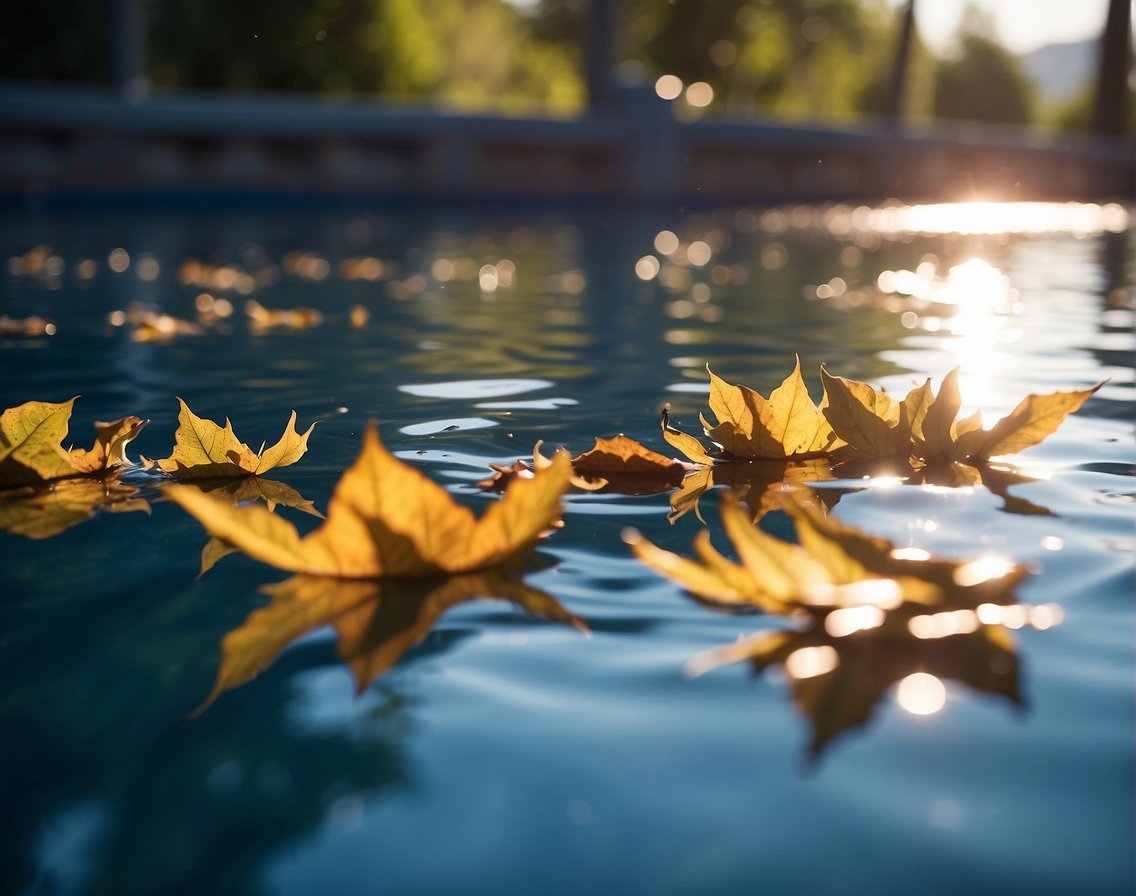
Pool skimming is a crucial step in routine pool maintenance. As pool owners, we must know that removing debris such as leaves, bugs, and dirt from the pool surface prevents it from sinking and affecting the pool’s cleanliness and chemistry.
Key Steps:
- Skim the surface to remove debris daily.
- Use a long-handled net for effective skimming.
- Regularly empty the pool skimmer baskets to maintain water flow.
Maintaining clean water is not only about aesthetics but also about health. A clean pool reduces the risk of algae and bacteria growth. This is important because unhealthy contaminants in the water can disrupt the water chemistry, leading to issues with the pH level and alkalinity.
Proper Pool Circulation:
- Ensure the pool pump runs effectively for adequate circulation.
- The pool’s filtration system should be checked and maintained.
- Regular vacuuming is required to complement skimming efforts.
Chemical balance in a swimming pool is critical. Regularly testing the water with a test kit allows us to monitor chlorine levels, alkalinity, pH balance, and other indicators of water chemistry. Adjustments using pool chemicals, as needed, will keep these levels within the appropriate range.
Pool Chemistry Maintenance:
- Measure and balance the chlorine, pH, and total alkalinity.
- Employ pool shock treatments periodically for sanitization.
- Brushing the pool walls helps prevent algae buildup.
In summary, understanding and implementing these fundamental practices in pool skimming and maintenance ensure a clean and healthy swimming environment. We maintain chemical balance and the overall integrity of the pool by regularly removing floating debris, checking the filtration system, and monitoring water chemistry.
Essential Pool Skimming Equipment
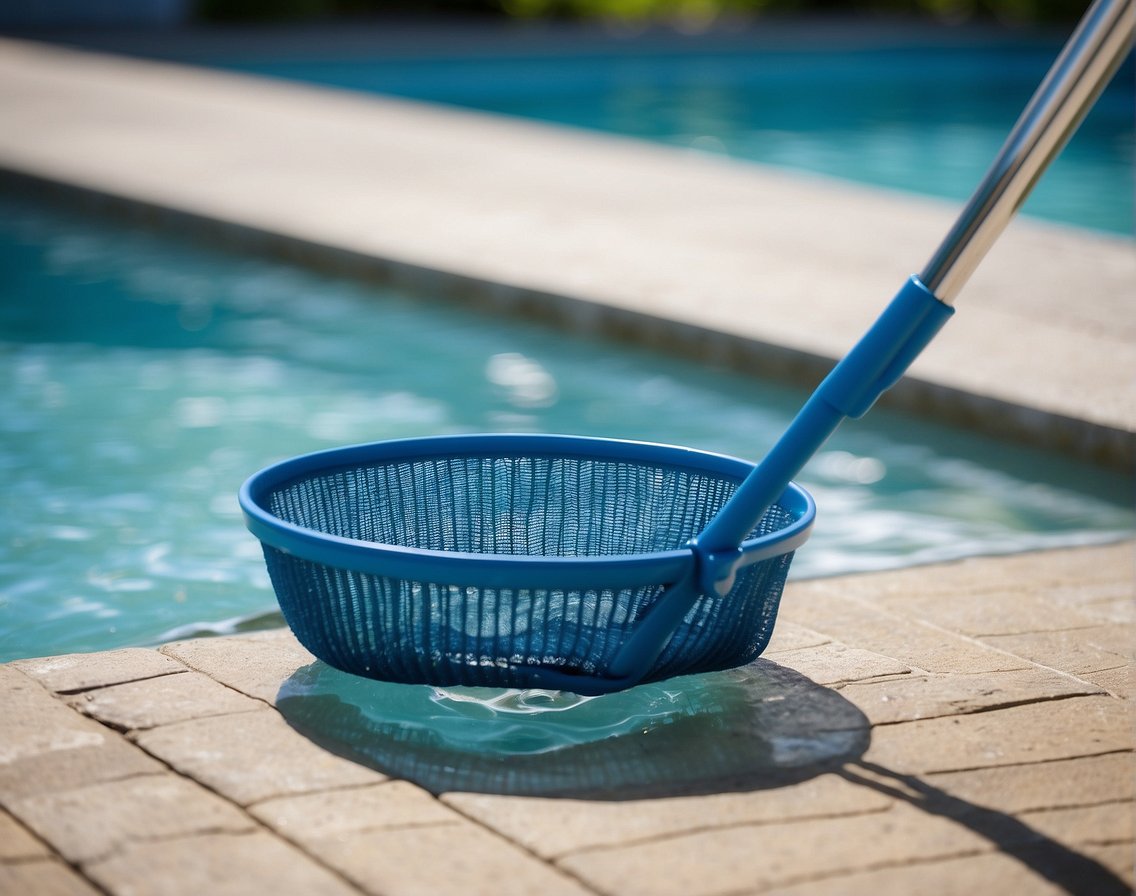
In maintaining a clean and welcoming swimming pool, selecting and maintaining the right equipment is crucial. Our focus in this section is the fundamental tools needed for effective pool skimming.
Choosing the Right Skimmer Net
A skimmer net is vital for removing debris from the water’s surface. When choosing a skimmer net, consider a flat net for light debris and a bag net for heavier leaves. The net should be made of a durable, fine mesh to capture even the smallest particles. Opt for a net with a wide mouth; it speeds up the cleaning process, making it more efficient for inground pool skimmers.
Maintenance of Skimmer Baskets and Pool Filters
- Skimmer Baskets: Regularly empty and inspect skimmer baskets, ensuring they’re free of cracks and securely attached. This prevents debris from clogging the suction line and pool filter.
- Pool Filters: Maintain your pool filter according to the manufacturer’s guidelines. A clean filter is pivotal in keeping the water circulatory system working effectively.
Importance of a Telescopic Pole
For complete coverage, we need a telescopic pole that easily extends to reach every part of the pool. Choose an adjustable and sturdy telescopic pole that can connect to the skimmer net, pool brush, and pool vacuum, ensuring all pool cleaning tools are readily accessible. Regularly inspect this equipment for signs of wear and tear to prevent unexpected breaks during use.
Skimming Techniques and Best Practices
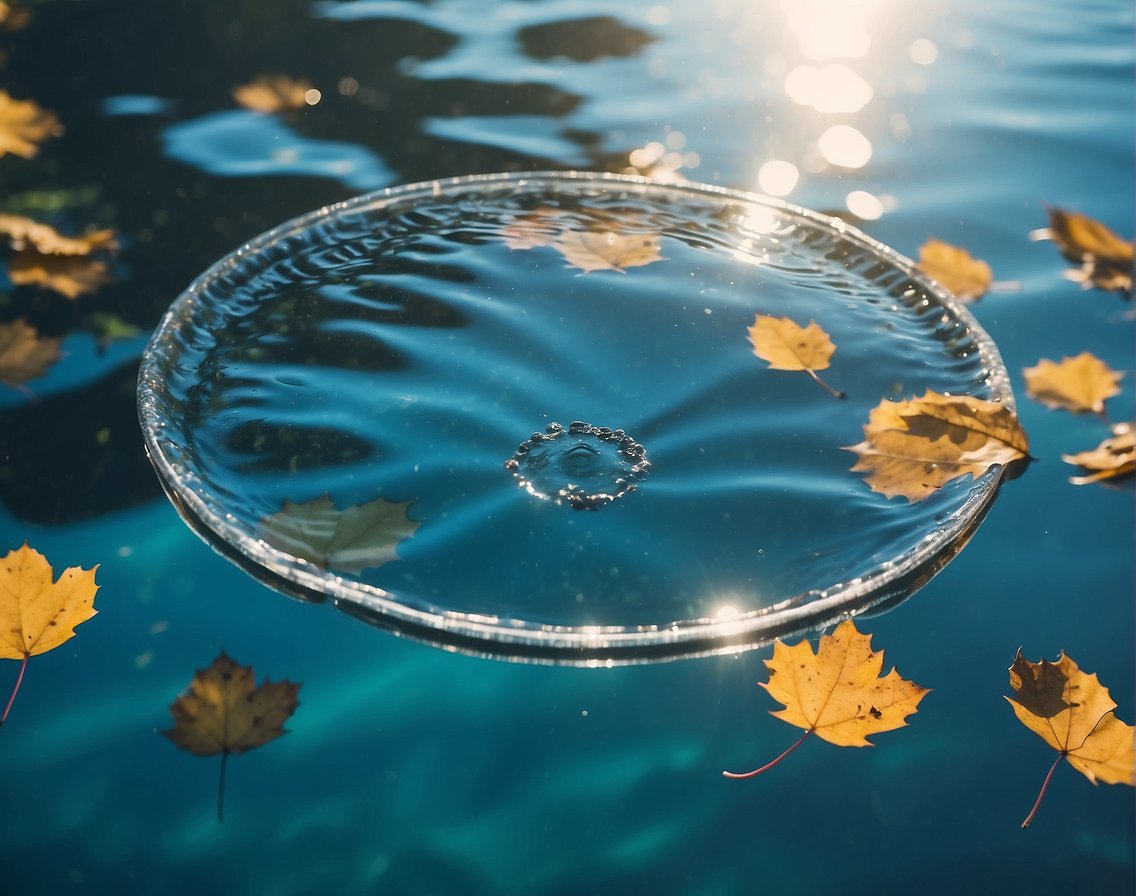
Effective pool skimming requires a combination of the right technique and choosing the appropriate skimmer type for your pool. Whether you’re using manual or automatic skimmers, the goal is to maximize cleaning power and efficiency.
Mastering the Manual Skimming Process
We recommend using a steady, methodical approach when manually skimming your pool. Here are key practices:
- Equip Yourself Properly: Ensure your manual pool skimmer has a fine mesh net for capturing both large debris and smaller particles.
- Skimming Motion: Use a slow, steady figure-eight motion to create a more consistent cleaning path without disturbing the water too much, which can push debris away from the skimmer.
- Overlap Your Paths: Each pass with the skimmer should slightly overlap the last, ensuring no debris is missed.
- Skimmer Maintenance: Clean the built-in skimmer basket regularly to prevent clogs that can diminish cleaning power.
- Edge Skimming: Focus on the edges of the pool where debris tends to accumulate, and ensure the mounted skimmer’s weir door is functioning correctly to optimize surface cleaning.
Implementing Automatic Pool Skimmers Effectively
Automatic skimmers can greatly reduce the effort involved in keeping a pool clean. Here’s how to implement them effectively:
- Choose the Right Skimmer: Select a model that’s compatible with your pool type. For example, above-ground pool skimmers may differ from those made for in-ground pools.
- Positioning: Ensure your automatic pool skimmer is properly positioned in your pool for optimal surface coverage.
- Regular Inspections: Even though they are automatic, check your skimmers regularly for blockages or any necessary adjustments to maintain peak performance.
- Combine with Manual Effort: Utilize an automatic skimmer for daily maintenance and complement it with manual skimming after events that leave a large amount of debris, like storms.
By adhering to these skimming techniques and best practices, we foster cleaner, more inviting pool water while streamlining our maintenance routines.
Optimizing Your Skimming Routine
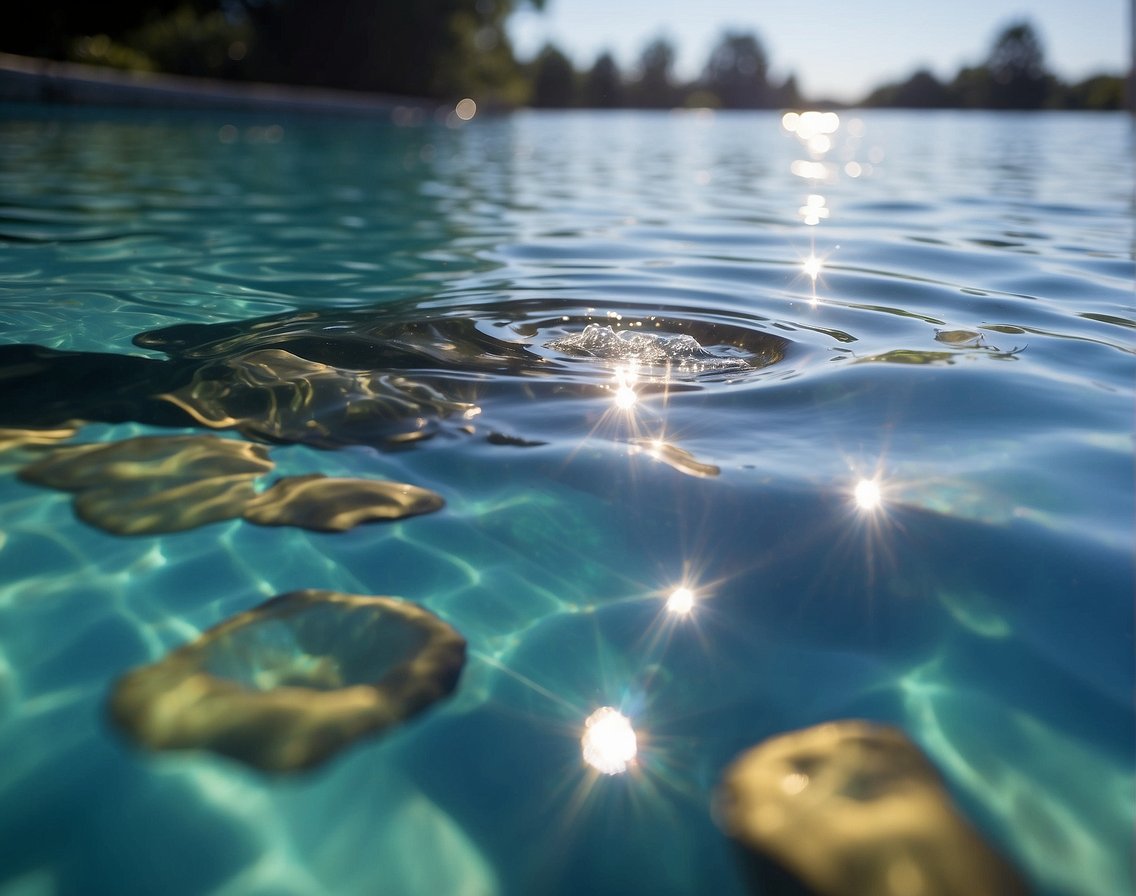
To maintain a pristine swimming pool, we must regularly remove debris from the water’s surface and integrate skimming into our comprehensive pool care regimen.
Timing and Frequency of Skimming
- Daily Skimming: Ideally, we should skim our pool daily, especially during the height of pool season when leaves and insects are most abundant.
- Circulation Patterns: Observing the pool’s circulation can help us determine the most effective times to skim. For instance, skimming is more efficient when the pool’s pump is running, as debris congregates in certain areas.
- Post-Event Cleaning: Should the pool undergo heavy usage or after a storm, an extra skimming session helps restore the pool’s cleanliness.
Incorporating Skimming into Overall Pool Maintenance
- Routine Maintenance Alignment: We synchronize our skimming with routine maintenance activities such as vacuuming and checking chemical levels to save time and enhance the pool’s overall health.
- Cleaning Equipment Care: Maintaining our skimmer and related equipment ensures they function efficiently. We must regularly inspect and clean the skimmer basket and ensure the skimmer net is free of holes or tears.
- Strategic Skimming: We utilize a strategic approach by starting at the downwind side and moving towards the opposite end, capturing the maximum amount of debris on the pool surface.
Addressing Common Pool Contaminants
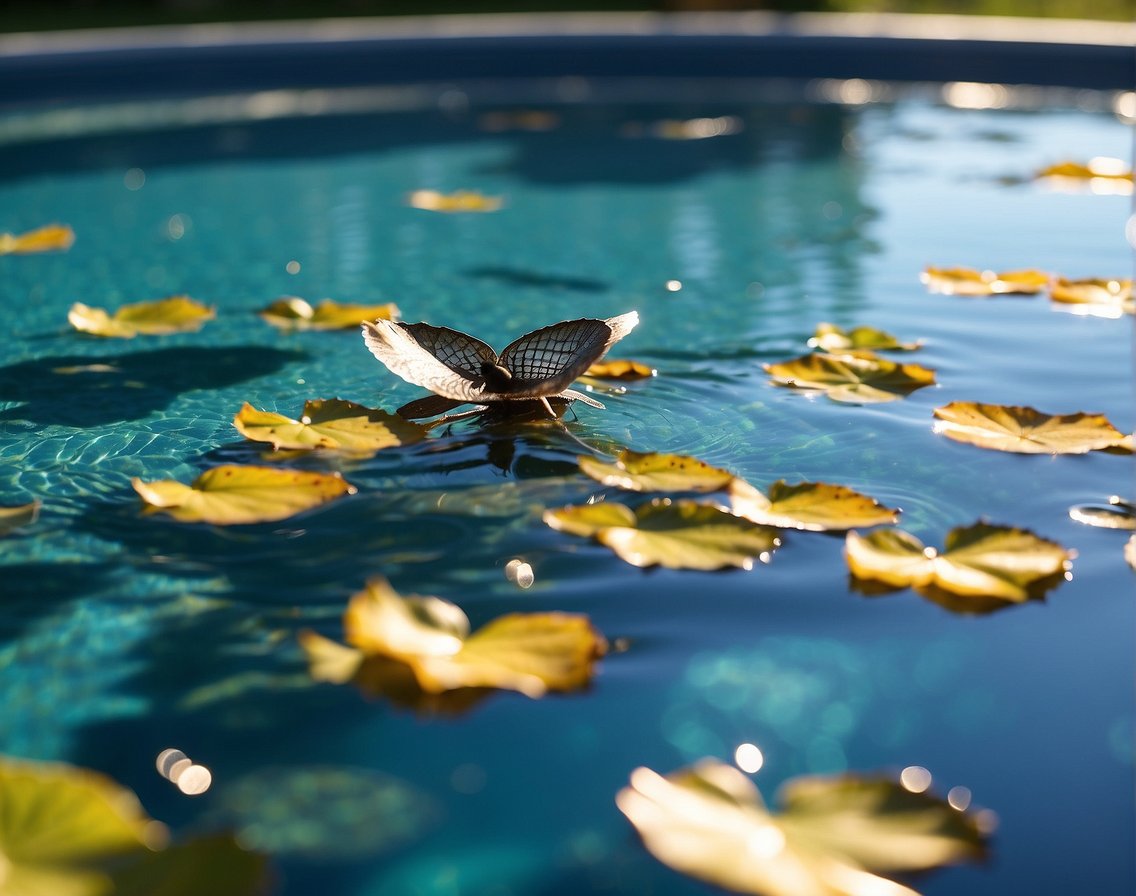
Addressing common pool contaminants efficiently is essential for maintaining a clean and safe swimming environment. We’ll cover strategies for removing physical debris as well as handling the more insidious growth of algae and bacteria.
Removing Leaves, Bugs, and Floating Debris
We can keep our pool water crystal clear by regularly skimming out leaves, bugs, and other floating debris. Here are some specific steps and tools we can use:
- Skimmer Net: Use a flat net for skimming the surface and a deep net for removing items submerged in the water.
- Regular Cleaning: Skim the pool surface daily, especially after windy days when more leaves and debris are likely to fall in.
Table 1: Skimming Schedule and Supplies
| Frequency | Tools Needed | Target Contaminants |
|---|---|---|
| Daily | Skimmer Net | Leaves, Bugs |
| After Wind | Skimmer Net | Flowers, Dirt |
Removing debris quickly is crucial because it prevents decay, which can affect water chemistry and clog filters.
Handling Algae, Bacteria, and Chemical Residue
Algae and bacteria require a more strategic approach involving water chemistry and regular maintenance.
- Chlorine Tablets: These help sanitize the water and address bacterial growth. Ensure they are used according to the pool’s volume and the manufacturer’s guidelines.
- pH Regulation: Test water pH levels weekly to maintain a range of 7.2 to 7.8. This balance ensures chlorine effectiveness and inhibits algae growth.
To deal with chemical residue and waterline build-up:
- Tennis Ball: Throwing a tennis ball into the pool can absorb oils, such as sunscreen and hair products, preventing residue formation.
- Pool Service: For more persistent problems or large pools, consider hiring a professional pool cleaning service for comprehensive chemical treatment and cleaning.
List of Chemical Balancing Essentials:
- Chlorine tablets
- pH test strips or kit
- Algaecide, if necessary
It is important for us to tackle contaminants proactively to ensure our pool remains a refreshing and inviting space.
Frequently Asked Questions
In this section, we cover the essentials to enhance your pool maintenance routine with effective tips for skimming.
What are the key steps for proper pool skimming?
We begin by ensuring the pool’s surface is free from debris using a long-handled skimmer. It’s important to clear out floating debris and then to gently brush the surface of the water in a consistent pattern to avoid missing spots.
How frequently should I skim my pool for optimal cleanliness?
We recommend skimming the pool at least once a day to maintain cleanliness and discourage algae growth. In windy conditions or when the pool is heavily used, we increase the frequency as necessary.
What techniques can I use to increase the efficiency of my pool skimmer?
To increase efficiency, we install a skimmer sock or fine mesh net to catch smaller particles, and we optimize water level to maximize skimmer performance. Strategic pool circulation and checking the skimmer basket regularly are also key.
What is the correct position for a pool skimmer valve for maximum effectiveness?
For the pool skimmer valve to effectively trap debris, we set it so the water flows through the skimmer at a rate that allows debris to be captured without escaping, which is typically a fully open position unless multiple skimmers are present.
Can a solar pool skimmer be as effective as traditional skimming methods?
A solar pool skimmer can be as effective if used under the right conditions. We ensure it is fully charged and deployed frequently to maintain surface cleanliness, especially in sunlit areas.
How to properly maintain and clean a pool skimmer box to ensure peak performance?
We maintain the skimmer box by regularly emptying it and checking for blockages, ensuring the weir gate operates freely, and inspecting the skimmer basket for integrity to prevent any bypass of debris back into the pool.
